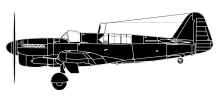
ASN Wikibase Occurrence # 240511
This information is added by users of ASN. Neither ASN nor the Flight Safety Foundation are responsible for the completeness or correctness of this information.
If you feel this information is incomplete or incorrect, you can submit corrected information.
| Date: | Wednesday 9 December 1953 |
| Time: | day |
| Type: |  Fairey Firefly FR Mk 1 |
| Owner/operator: | 766 Sqn FAA RN |
| Registration: | PP587 |
| MSN: | F.6261 |
| Fatalities: | Fatalities: 1 / Occupants: 1 |
| Aircraft damage: | Destroyed |
| Location: | The Manacles, 1 mile ESE of Manacle Point, Falmouth Bay, Cornwall -
 United Kingdom United Kingdom
|
| Phase: | En route |
| Nature: | Military |
| Departure airport: | RNAS Culdrose (HMS Seahawk), Lizard Peninsula, Cornwall (EGDR) |
| Confidence Rating: |
Fairey Firefly FR.Mk.1 PP587: Built by Fairey Aircraft at Hayes, and first flown at White Waltham. Maidenhead, Berkshire. Delivered to the FAA RN (Fleet Air Arm Royal Navy) 9/5/1946 at RNAS Culham RDU. First issued for service to 795 Squadron FAA RN at HMS Gannet, RNAS Eglinton in October 1946.
Transferred to 827 Squadron FAA RN in December 1946 and embarked aboard HMS Triumph. Sustained severe damage in a landing accident aboard HMS Triumph 8/5/1947 when stalled on landing, starboard wing "dipped", caught the deck of the carrier, and starboard undercarriage collapsed. Pilot - Lieutenant K.G.Treeweeke - uninjured. Off loaded for repairs and storage upon completion of work
Next recorded at the School of Land/Air Warfare at RAF Old Sarum, Salisbury, Wiltshire in January 1949 (until January 1951). Withdrawn to RNAY Fleetlands for overhaul and storage by/in July 1951. Transferred to RNAS Abbotsinch AHU for further storage from January 1952. Next issued for service with 766 Squadron FAA RN at HMS Seahawk, RNAS Culdrose, Cornwall from 30/10/1953.
Written off (destroyed) 3/12/1953 when ditched into the sea near a series of rocks called "The Manacles", (Cornish: Meyn Eglos, meaning church stones) (at approximate coordinates 50°2′ 40.63″N, 5°2′46.18″W) are a set of treacherous rocks off The Lizard peninsula in Cornwall. The rocks are in Falmouth Bay and extends about one nautical mile east and south-east of Manacle Point, on the east coast of the Lizard Peninsula. The nearest village is Porthoustock. Pilot - Sub Lieutenant Neil Boden, Royal Australian Navy - was killed.
According to the official biography of the pilot (see link #3):
"Neil Boden was born on 27 May 1931 at Cairns, North Queensland, and enlisted in the Royal Australian Navy, at Melbourne, on 12 May 1952, for 6 years. (Service Number R47468). His mother Mabel Boden was listed as his next-of-kin. At the time the RAN was actively seeking direct entry Naval Airman Trainees for RAN Fleet Air Arm, which is the branch Boden volunteered for.
On 12 May 1952 Boden was drafted to HMAS Cerberus on Western Port Bay, south of Melbourne, to begin basic training as a naval recruit then for Aircrew assessment. Having passed the necessary qualifications on 12 August 1952 he was rated Probational Naval Airman (Aircrew) and drafted to the RAAF base at Archerfield, near Brisbane, where he was enrolled in the No.1 Flying Training School to commence training as a pilot. The course covered flight theory and aeronautical knowledge, followed by practical exercises flying the DH 82 Tiger Moth.
After reaching the required standard and necessary hours on Tiger Moths, Boden was transferred to RAAF Uranquinty, in country NSW, joining the No.1 Basic Flying School for further weapons and combat training in the more powerful Wirraway aircraft. After graduating on 15 September 1953 with his ‘wings’, Boden transferred to HMAS Cerberus for a Divisional Course and to be promoted Acting Sub-Lieutenant (Pilot). His next move was to the UK for advanced training with the RN FAA, embarking on RMS Strathmore at Port Melbourne on 22 September 1953, for passage to the UK
Boden arrived in the UK on 25 October 1953 and was posted to HMS Seahawk (RNAS Culdrose), near Helston, Cornwall. At HMS Seahawk he joined the Operational Flying School Part 1 Course. This included developing his flying skills, defensive techniques, weapons training, fleet exercises and deck landing on an aircraft carrier. The course was intense, and involved anti-submarine exercises with long-range flights over the ocean in a Fairey Firefly aircraft.
On 9 December 1953, Acting Sub-Lieutenant (Pilot) Neil Boden RAN, while flying a Firefly on an anti sub-marine exercise along the East Coast of Cornwall’s Lizard Peninsula, was reported overdue. Although a wide area search over land and sea was conducted, no trace of Boden or his aircraft was discovered, and he was declared ‘missing presumed dead’.
Fairey Firefly PP587 was formally Struck Off Charge as Cat.ZZ on 14/12/1953. Total flying hours on airframe: 347.40
Sources:
1. Fleet Air Arm Fixed Wing Aircraft Since 1946 (Ray Sturtivant, Lee Howard & Mick Burrow, Air Britain, 2004 p.252)
2. National Archives (PRO Kew) - Aircraft Accidents: Firefly FR Mk 1 PP587 on 9.12.1953: File ADM 1/24595: https://discovery.nationalarchives.gov.uk/details/r/C4845708
3. https://www.faaaa.asn.au/boden-neil/
4. https://en.wikipedia.org/wiki/The_Manacles
.
Revision history:
| Date/time | Contributor | Updates |
|---|---|---|
| 26-Aug-2020 19:31 | Dr. John Smith | Added |
| 27-Aug-2020 10:30 | Angel Dick one | Updated [Operator, Operator] |
| 02-Sep-2020 19:37 | Dr. John Smith | Updated [Source, Narrative] |
| 04-Sep-2020 22:08 | Dr. John Smith | Updated [Source] |
| 04-Sep-2020 22:08 | Dr. John Smith | Updated [Aircraft type] |
Corrections or additions? ... Edit this accident description
The Aviation Safety Network is an exclusive service provided by:


 ©2024 Flight Safety Foundation
©2024 Flight Safety Foundation